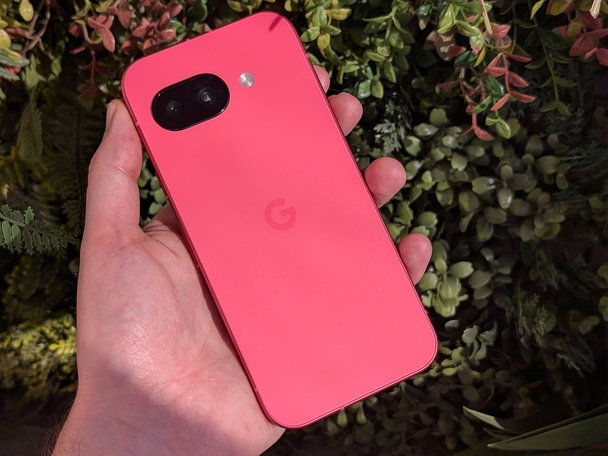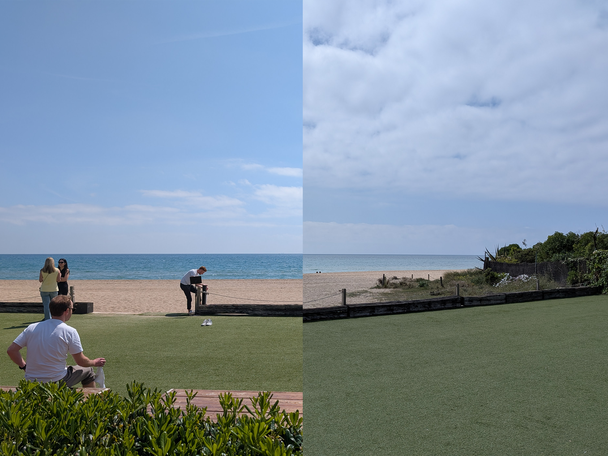Design and build quality
The Pixel 9a ditches the full-width camera bump of its predecessor, instead getting a flush camera array and a thicker body overall. That’s an oddly rare design for phones that have been rocking bumps and camera islands of all shapes and sizes for years. It gives the Pixel 9a a neat and tidy aesthetic that borders on boring. If you’re switching from a phone with a more premium edge-to-edge display, the bezels are hard to ignore, but they’re hardly intrusive and are easy to get used to. They’re also readily forgiven on a phone costing less than £500.
Build quality is high, but the Pixel 9a saves money with a plastic back panel. It feels pleasant enough to touch, but, as you’d expect, it lacks the premium feel of the glass-backed flagships. It’s also way less likely to shatter when dropped, which is a bonus for clumsy users. The frame comes in sturdy aluminium, giving the phone a reassuring rigidity, but the front of the phone is a cheaper grade of Gorilla Glass than that found on the main Pixel 9 series.
At 6.3in, it’s a comfortable phone to hold and reasonably lightweight too, making one-handed use manageable for most. The IP68 rating is an upgrade on the Pixel 8a’s IP67, making the phone water resistant and dustproof and offering peace of mind against accidental splashes – a welcome feature at this price. Colour options are typically playful, too; my review unit is a bold peony pink, though you’ve got the choice of a blueish-purple, iris colourway, or plain back or white.

Display
The Pixel 9a sports a bigger and brighter 6.3in OLED display with HDR10 support. The screen is sharp and vibrant, with deep blacks and punchy colours. An improved peak brightness of 2700 nits means visibility outdoors and in direct sunlight is good and not too far off the brightness of the top-end Pixel 9 Pro.
Google has equipped the Pixel 9a with a smooth 120Hz adaptive refresh rate, similar to that found on the Pixel 8a – this has been switched off by default, though, to preserve battery life. This makes scrolling through feeds, navigating menus and playing compatible games feel more fluid and responsive. It also leaves the 60Hz display of Apple’s cheaper iPhone 16e looking drab by comparison.

Performance and battery life
Under the bonnet, the Pixel 9a runs on the same Tensor G4 chip found in the flagship Pixel 9 phones, albeit with a little less RAM to play around with – the 9a has 8GB rather than the 12GB and 16GB found in the more expensive flagships.
Performance feels snappy and responsive all the same, with the cheaper Pixel easily handling graphically intense gaming without melting down. Apps open quickly, multitasking is handled smoothly, and the Android interface glides along thanks to that 120Hz display and Google’s software optimisation.
The real benefit of the Tensor G4 on the Pixel 9a is its ability to run Google’s latest AI features on-device, ensuring the Pixel’s headline features, such as magic eraser, photo unblur and add me, run quickly and privately. Like most Android phones, you also get Gemini – Google’s AI assistant – on the device. It is evolving constantly, adding new features, including the ability to hold a natural back-and-forth conversation. You can also share your camera with the AI to ask it questions about the world around you.
The thicker chassis of the Pixel 9a houses the biggest battery of any Pixel phone at 5,100mAh, giving the £499 device an impressive 30-hour battery life. Combined with Tensor’s clever battery management, the Pixel 9a comfortably lasts a full day of fairly heavy usage – think emails, social media, some camera use, and music streaming. The 9a even gets wireless charging, albeit at 7.5W – that’s slow if you’re in a hurry, but it’s perfectly fine for overnight charging using the Pixel Stand.
Camera
Cameras are where the Pixel 9a makes the biggest compromise versus more expensive alternatives. It uses a smaller light sensor and lacks the telephoto lens of the Pixel 9 Pro, but the Pixel 9a still rocks a decent 48MP main camera with stabilisation alongside a 13MP ultrawide lens for wide-angle shots. Compare that to the more expensive iPhone 16e, which makes do with just a single camera – albeit a better quality one. The 9a also benefits from Google’s industry-leading image processing and AI smarts.

The results are impressive for a phone at this price, though the downgraded camera hardware sometimes struggles, especially in dull or challenging lighting conditions, like heavily backlit subjects or scenes with lots of contrast. The night sight and astrophotography modes – which let you take long exposure shots in the dark and create short timelapse videos of starry skies – are welcome for such an affordable device. Photography on the Pixel 9a is good enough for the price, and that’s, well, good enough.
The real value of the Pixel’s camera offering, however, lies in the suite of AI editing features accessible through Google Photos. Magic eraser removes unwanted objects or people, using generative AI to seamlessly replace them. Best take ensures everyone looks their best in group shots by merging multiple photos together. Photo unblur can sharpen slightly soft images, and audio eraser can remove distracting sounds from videos.

Software
The Pixel 9a runs on the latest version of Android, naturally enough, which means you’re getting the cleanest and best user experience of any non-Apple smartphone on the market. The Pixel interface is smooth and user-friendly, integrates well with other Google tech like the Pixel Watch and Pixel Buds, and offers a bunch of extra security features not found on other Android devices. Facial recognition lets you unlock the phone at a glance, but Pixel phones allow you to use your face to log into secure apps, like your banking app, without any additional fiddly steps.
The Pixel 9a receives an impressive seven years of support, including OS upgrades, security patches and regular feature drops that add new functionality over time.




